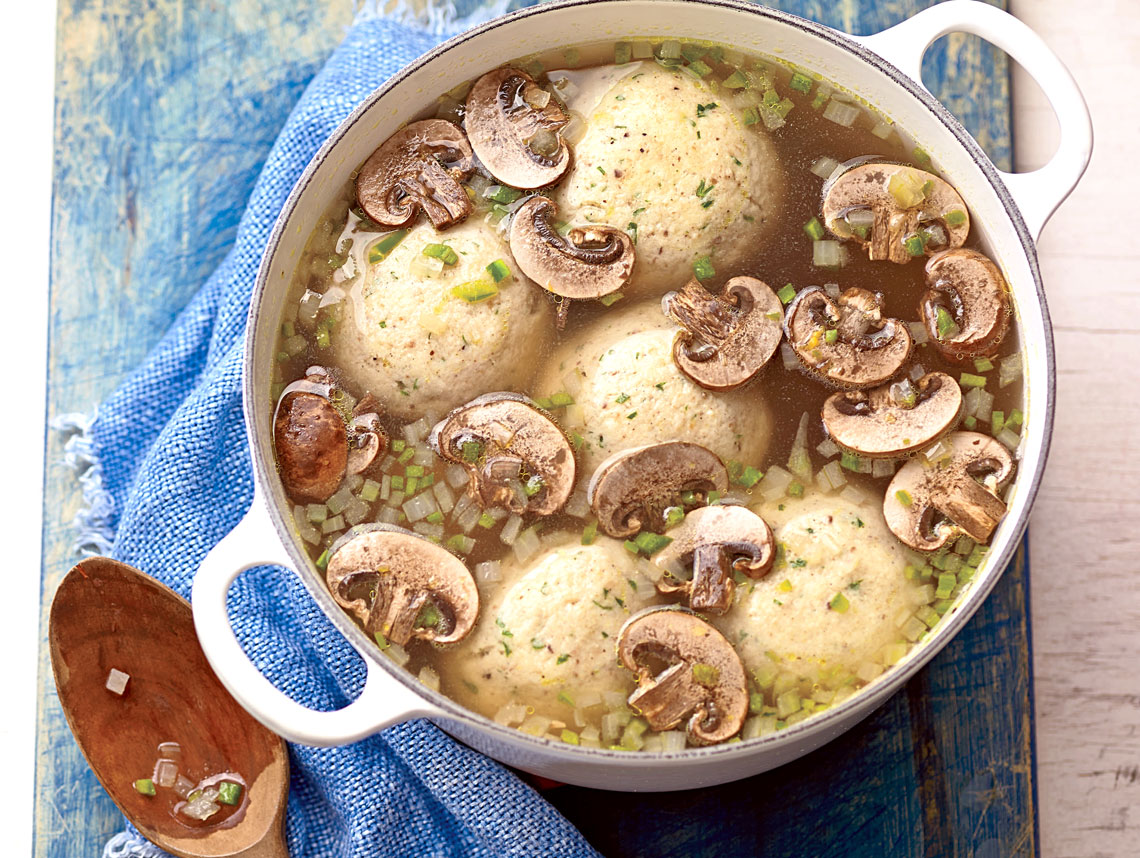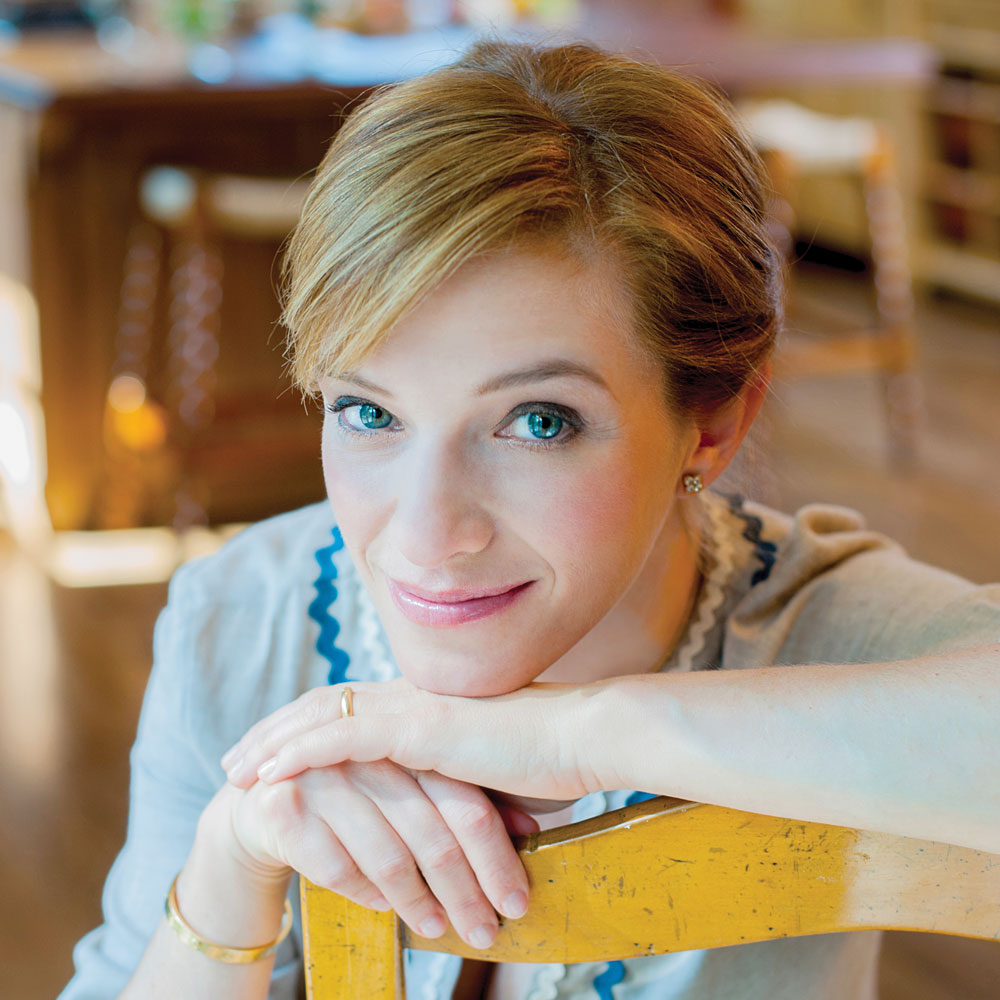 Matzo Balls with Mushrooms and Jalapeños in Broth. Photo by Ellen Silverman
Matzo Balls with Mushrooms and Jalapeños in Broth. Photo by Ellen Silverman Celebrity chef Pati Jinich grew up in Mexico City, where she spent Shabbat dinners at her bubbe’s house.
“When we walked into her house,” Jinich fondly recalls of her grandmother, “the first thing she had was a big, gigantic bowl of guacamole, but it was a Yiddish version, because it was a combination of chopped egg salad and guacamole. Next to that, she would have a big bowl of gribenes” — crisp chicken or goose skin — “with fried onions. And then she already had sliced challah. So you would grab a slice of challah, put the chopped egg guacamole mixture on top, and then you top it with gribenes.”
This Mexican-Jewish fusion runs deep in Jinich’s family, as it does for many other Mexican Jews.
“It’s become fashionable to do a Latin theme on Jewish foods, but a lot of people don’t realize that Mexican-Jewish cuisine is really deeply rooted,” says Jinich, who stars in the hit national PBS cooking show “Pati’s Mexican Table.” “It’s not just, ‘Oh, I’m gonna throw a chili in here, or some spices.’ There’s a full Mexican-Jewish vocabulary that has existed for centuries.”
Jinich’s bubbe also made p’tcha (pickled calf foot), but instead of serving it with horseradish, she served her version with pico de gallo.
Sephardic Jews fleeing the Spanish Inquisition first came to Mexico more than 500 years ago. Larger waves of Jewish immigrants arrived over the past 150 years, most of them from Eastern Europe, Syria and the former Ottoman Empire. Today, the Jewish population in Mexico is close to 50,000, most of them living in Mexico City.
So the idea of Mexican-Jewish fusion is not something new for Mexican Jews like Jinich; it was part of life while she was growing up. For example, Jinich points to Gefilte Fish a la Veracruzana, which has a sauce of tomatoes, capers, pickled chilies, olives, cilantro and parsley.
“The Jewish community thought of using it for fish patties — gefilte fish,” she said. “So that’s a standard — a must — in many Jewish Ashkenazi homes. Instead of eating the gefilte fish cold with aspic, which you need an acquired taste to love, Mexican-style gefilte fish is served warm, in that thick, spicy tomato broth. And it’s really irresistible.”
Jinich, 44, traces her roots to Poland and central Europe — her grandparents fled pogroms and immigrated to Mexico City in the early 20th century. As a young adult, she became an immigrant herself, following her Mexican-Jewish husband to the United States 20 years ago. Jinich, now a mother of three boys, lives in Washington, D.C., where her television show, currently in its fifth season, originates in her home kitchen.
Although Jinich is a natural in the kitchen and on camera, she began her career as a policy analyst, focused on Latin American politics. But her passion for food — and especially the cuisine of Mexico — brought her to culinary school in 2005. Before becoming a chef, she taught Mexican cooking to friends and neighbors while living in Dallas in the late 1990s and served as a production assistant on another PBS food series, “New Tastes From Texas,” a show that featured guest hosts such as Mexican food pioneers Diana Kennedy and Patricia Quintana.
Jinich has published two cookbooks, “Pati’s Mexican Table: The Secrets of Real Mexican Home Cooking” (2013) and “Mexican Today: New and Rediscovered Recipes for Contemporary Kitchens” (2016). And her television show, which screens all over the world, has been nominated for two Emmys and two James Beard Awards, the Oscars of the food world.

In short, Jinich has become a 21st-century ambassador to Mexican cuisine in the United States. But she brings a modern sensibility to the foods of her native country, which are being rediscovered with renowned chefs such as Denmark’s René Redzepi of Noma, who is opening a satellite of his famed restaurant in Mexico, and Enrique Olvera, who has been featured on Netflix’s popular series “Chef’s Table.”
Jinich sees the culinary world’s recent attention to Mexico as inspiring.
“For a long time, everyone took Mexican food for granted,” she explains. “It took this new cadre of chefs looking at Mexican cuisine and taking all the traditional elements and presenting them in a more sexy, modern way. Not only for the outside to recognize the richness and sophistication of Mexican cuisine, but also for Mexicans. Mexicans are so excited about their own cuisine. Now, it’s going back to the roots — sometimes to the extreme — and really highlighting what makes Mexican food so unique. And I think Mexican cuisine is having a very big moment. There’s so much to explore.”
With recipes such as Asparagus, Mushroom and Goat Cheese Enchiladas with Pine Nut Mole Sauce or Mexican Thanksgiving Turkey, Jinich has an approach that is more accessible than many of the chefs currently helming the Mexican dining scene. She lives by the credo that any home cook can bring the warmth and color of Mexico into the kitchen.
And although Jinich is Jewish, her recipes are, for the most part, Mexican. She did not grow up attending Jewish schools or eating kosher food. At the same time, following in the footsteps of her bubbe, as well as an Austrian grandmother who taught her how to make matzo ball soup (recipe below), she treasures the dishes of her Mexican-Jewish repertoire
“What happened with Ashkenazi food, which is sort of bland, is that it got blessed with all the warmth and colors and flavors of Mexico. It was like a gift to Ashkenazi cuisine.”
“Blessed” is how Jinich also describes her own multifaceted identity. Despite feeling “shaken” by the current political climate in the U.S., she sees herself as simultaneously Mexican, Jewish and American.
“I used to tell my children as Mexican Americans, you’ve been doubly blessed, but you’re doubly responsible,” she says. “You have to be proud about being Mexican, and you have to make Mexico proud, and you have to make your Mexican family proud. And at the same time, you have to be grateful to America and responsible as an American citizen. And one cannot forget the third element, which is about being a Jew and the Jewish values.”
It’s a recipe for life Jinich clearly embraces.
MATZO BALLS WITH MUSHROOMS AND JALAPEÑOS IN BROTH
From “Mexican Today: New and Rediscovered Recipes for Contemporary Kitchens” by Pati Jinich (Houghton Mifflin Harcourt, 2016).
– 1 cup (2 2-ounce packages) matzo ball mix
– 2 tablespoons fresh parsley, finely chopped
– 1/4 teaspoon grated nutmeg
– 1 1/2 teaspoons salt, or to taste
– 4 large eggs
– 1/2 cup canola or safflower oil, divided
– 2 tablespoons sesame oil
– 1 tablespoon sparkling water (optional)
– 1/2 cup white onion, finely chopped
– 1 garlic clove, finely chopped
– 2 jalapeño chilies, seeded if desired and finely chopped, more or less to taste
– 1/2 pound white and/or baby bella (cremini) mushrooms, cleaned, dried, part of the stem removed, thinly sliced
– 8 cups chicken broth, homemade or store-bought
In a large mixing bowl, combine the matzo ball mix, parsley, nutmeg and 3/4 teaspoon salt.
In a small bowl, lightly beat the eggs with 6 tablespoons of vegetable oil and 2 tablespoons of sesame oil. Fold the beaten eggs into the matzo ball mixture with a spatula. Add the sparkling water if you want the matzo balls to be fluffy, and mix until well combined. Cover the mixture and refrigerate for at least 30 minutes.
In a large soup pot, bring about 3 quarts salted water to a rolling boil over high heat. Bring heat down to medium and keep at a steady simmer. With wet hands, shape the matzo ball mix into 1- to 1 1/2-inch balls and gently drop them into the water. Reduce heat to low, cover and simmer for about 25 to 30 minutes, or until matzo balls are completely cooked and have puffed up.
Meanwhile, heat the remaining 2 tablespoons oil over medium heat in a soup pot. Add the onion, garlic and chilies and sauté for 4 to 5 minutes, until they have softened a bit. Stir in the sliced mushrooms, add 3/4 teaspoon salt, stir and cover the pan. Steam the mushrooms for about 6 to 8 minutes, remove the lid and continue to cook uncovered until the liquid in the pan evaporates. Add the chicken broth and bring to a simmer. Taste and adjust seasoning. Add the cooked matzo balls (use a slotted spoon if transferring from their cooking water) and serve.
Makes 8 servings.
GEFILTE FISH A LA VERACRUZANA
A standard in Jewish homes across Mexico. Courtesy of Pati Jinich.
– Gefilte Fish Patties (recipe follows)
– 3 tablespoons safflower or corn oil
– 1/2 cup white onion, chopped
– 1 can (28 ounces) crushed tomatoes
– 3 cups water
– 2 tablespoons ketchup
– 1 teaspoon salt, or to taste
– 1/4 teaspoon ground white pepper, or to taste
– 1 cup Manzanilla olives stuffed with pimientos
– 8 pepperoncini peppers in vinegar brine/chiles güeros en escabeche, or more to taste
– 1 tablespoon capers
Prepare Gefilte Fish Patties; set aside.
Heat the oil in a large cooking pot over medium-high heat. Add the chopped onion, and let it cook for 5 to 6 minutes, stirring, until soft and translucent. Pour the crushed tomatoes into the pot, stir and let the mix season and thicken for about 6 minutes. Incorporate 3 cups water, 2 tablespoons ketchup, salt and white pepper, give it a good stir and bring to a boil. Turn down the heat to low, to get a gentle simmer, as you roll the Gefilte Fish Patties.
Place a small bowl with lukewarm water to the side of the simmering tomato broth. Start making the patties, about 2 1/2 inches by 1 inch and about 3/4-inch thick. Wet your hands as necessary, so the fish mixture will not stick to your hands. As you make them, slide them gently into the simmering broth. Make sure it is simmering and raise the heat to medium if necessary to keep a steady simmer.
Once you finish making the patties, cover the pot and turn the heat to low. Cook them covered for 25 minutes. Take off the lid, incorporate the Manzanilla olives, pepperoncini peppers and capers. Give it a soft stir and simmer uncovered for 20 more minutes, so the gefilte fish will be thoroughly cooked and the broth will have seasoned and thickened nicely. Serve hot with slices of challah and spiced-up pickles.
Makes about 20 patties.
GEFILTE FISH PATTIES
– 1 pound red snapper fillets, no skin or bones
– 1 pound flounder fillets, no skin or bones
– 1 white onion (about 1/2 pound), quartered
– 2 carrots (about 1/4 pound), peeled and roughly chopped
– 3 eggs
– 1/2 cup matzo meal
– 2 teaspoons salt, or to taste
– 1/2 teaspoon ground white pepper, or to taste
Rinse the fish fillets under a thin stream of cool water. Slice into smaller pieces and place in the food processor. Pulse for 5 to 10 seconds until fish is finely chopped but hasn’t turned into a paste. Turn fish mixture onto a large mixing bowl.
Place the onion, carrots, eggs, matzo meal, salt and white pepper in same bowl of food processor. Process until smooth and turn onto the fish mixture. Combine thoroughly.
Lara Rabinovitch Neuman works for Google as a food writer and regularly teaches food culture courses at the Skirball Cultural Center.






















 More news and opinions than at a Shabbat dinner, right in your inbox.
More news and opinions than at a Shabbat dinner, right in your inbox.